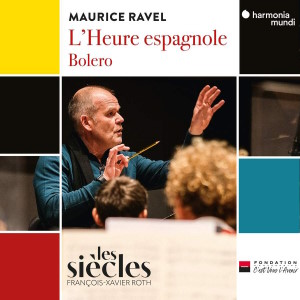
Maurice Ravel (1875-1937)
L’heure espagnole (1911)
Bolero (1928)
Concepción, Isabelle Druet (mezzo-soprano); Gonzalve, Julien Behr (tenor); Torquemada, Loïc Félix (tenor); Ramiro, Thomas Dolié (baritone); Don Iñigo Gomez, Jean Teitgen (bass)
Les Siècles/François-Xavier Roth
rec. 2021, Studio RIFFX 1, La Seine Musicale, Boulogne-Billancourt, France
French libretto with English translations enclosed.
Reviewed as download from press preview.
Harmonia Mundi HMM905361 [64]
Ravel had ambitions to compose five operas, but only two came into being; L’heure espagnole (1911) and L’enfant et les sortilèges (1926). L’heure espagnole, described as a comédie musicale, has a plot that is completely improbable. Moreover it was initially regarded as risqué and the premiere was postponed a couple of years by the Director of the Opéra-Comique, since he didn’t want to ruin Ravel’s career. When it finally was premiered on 19 May 1911, its reception was mixed. I can’t resist quoting the influential critic Jean Marnold who, in Mercure de France, some weeks later, wrote:
“Concepción is simply the kind of flighty little woman of whom there are shedloads, who is in the habit of deceiving her husband at least once a week while he is away performing his professional duties as a clockmaker. The two lovers are ridiculous in different ways and equally impotent, so that, having come there by chance and after having shown off his ‘biceps’ by nonchalantly transporting clocks in which the wishy-washy suitors are concealed, the vigorous muleteer reaps the benefits of the lovely lady’s disappointment and annoyance.”
Unless you are extremely prudish, this summary shouldn’t deter you from enjoying this opera, bearing in mind that it takes place during the 18th century in Spanish Toledo. Naturally the visual effects are missing when only listening, but the stage instructions are so detailed in the libretto, and – most important of all – the orchestra provides every movement, every little nuance in the proceedings. Ravel’s orchestration is a marvel of precision and colouring. Stravinsky once famously called Ravel “a Swiss watchmaker” and there is a lot of truth in that. The crisp playing of Les Siècles on period instruments further enhances this impression. One could easily say that the orchestra plays the principal part in the opera, while the singers perform in a parlando style, a kind of recitative, and Ravel himself stressed that they should “speak rather than sing their score”. The only exceptions are Concepción’s dramatic outbreak Oh ! La pitoyable aventure ! (track 18) and a couple of solos for Gonzalve, but there is still a lot of occasional vocal beauty sprinkled in, even though you can’t expect much extended bel canto singing. On the other hand you can count on a lot of expressive word-painting from all five characters.
The heaviest burdens rest on the shoulders of Thomas Dolié (Ramiro) and Isabelle Druet (Concepción). Both have long experience of their roles from stage performances, but their colleagues are also well inside their roles. There have been quite a few recordings of this work through the years, from a set recorded in 1929 under the supervision of the composer, and during the early CD era sets conducted by Cluytens, Ansermet and Leibowitz. I have long treasured a DG recording from 1963 conducted by Lorin Maazel with a starry cast including Jane Berbié (Concepción), Michel Sénéchal (Gonzalve), Jean Giraudeau (Torquemada), Gabriel Bacquier (Ramiro) and José van Dam (Don Iñigo Gomez). I returned to it for comparison purposes, and it still stands the test, but this new set is in no way inferior and probably sounds more like what the premiere audience heard in 1911.
Into the bargain, you also get the ubiquitous Bolero from 1928. The common denominator is of course the Spanish background. Though French by birth, Ravel had a penchant for Spanish rhythms, and he also composed the oft-recorded Rhapsodie espagnole in five movements as early as 1907. Bolero was composed for the Ida Rubinstein Ballets, but it is mostly performed as a concert piece. The first to conduct it in concert was Arturo Toscanini, but Ravel disliked his readings. In an interview in 1931, he said: “Toscanini conducts it twice as fast as it should go, and broadens out at the end, which is not indicated anywhere. No: Bolero must be performed at one tempo, from beginning to end, in the whining and monotonous style of Spanish-Arabian melodies.” Toscanini “rushed through it” in just under fourteen minutes. On a Naxos recording, Adrian Leaper and the RPO clock in at 13:33 and beat Toscanini by a neck, while Solti, who was no dawdler, needs 14:42. Roth on this disc is only marginally slower at circa 15:12, and to me this seems an ideal tempo, played at a steady pace. Checking at random a couple of dozen well-known conductors, I found a span from 13:28 (Ferenc Fricsay) to 17:32 (Daniel Barenboim with the Orchestre de Paris). A difference of a little more than four minutes for so short a work is clearly very much. I wonder what Ravel himself would have said.
Anyway, no one interested in these two works will feel short-changed by their acquisition.
Göran Forsling
Help us financially by purchasing from




















